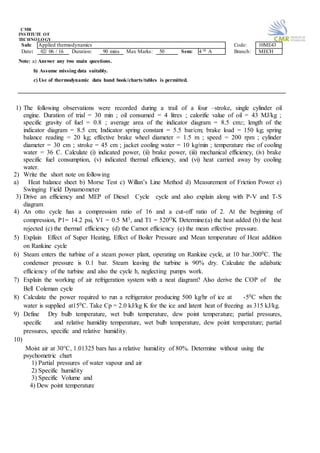Atd a sec
- 1. CMR INSTITUTE OF TECHNOLOGY Sub: Applied thermodynamics Code: 10ME43 Date: 02/ 06 / 16 Duration: 90 mins Max Marks: 50 Sem: 4 th A Branch: MECH Note: a) Answer any two main questions. b) Assume missing data suitably. c) Use of thermodynamic data hand book/charts/tables is permitted. 1) The following observations were recorded during a trail of a four âstroke, single cylinder oil engine. Duration of trial = 30 min ; oil consumed = 4 litres ; calorific value of oil = 43 MJ/kg ; specific gravity of fuel = 0.8 ; average area of the indicator diagram = 8.5 cm2; length of the indicator diagram = 8.5 cm; Indicator spring constant = 5.5 bar/cm; brake load = 150 kg; spring balance reading = 20 kg; effective brake wheel diameter = 1.5 m ; speed = 200 rpm ; cylinder diameter = 30 cm ; stroke = 45 cm ; jacket cooling water = 10 kg/min ; temperature rise of cooling water = 36 C. Calculate (i) indicated power, (ii) brake power, (iii) mechanical efficiency, (iv) brake specific fuel consumption, (v) indicated thermal efficiency, and (vi) heat carried away by cooling water. 2) Write the short note on following a) Heat balance sheet b) Morse Test c) Willanâs Line Method d) Measurement of Friction Power e) Swinging Field Dynamometer 3) Drive an efficiency and MEP of Diesel Cycle cycle and also explain along with P-V and T-S diagram 4) An otto cycle has a compression ratio of 16 and a cut-off ratio of 2. At the beginning of compression, P1= 14.2 psi, V1 = 0.5 M3, and T1 = 520OK Determine:(a) the heat added (b) the heat rejected (c) the thermal efficiency (d) the Carnot efficiency (e) the mean effective pressure. 5) Explain Effect of Super Heating, Effect of Boiler Pressure and Mean temperature of Heat addition on Rankine cycle 6) Steam enters the turbine of a steam power plant, operating on Rankine cycle, at 10 bar.3000C. The condenser pressure is 0.1 bar. Steam leaving the turbine is 90% dry. Calculate the adiabatic efficiency of the turbine and also the cycle h, neglecting pumps work. 7) Explain the working of air refrigeration system with a neat diagram? Also derive the COP of the Bell Coleman cycle 8) Calculate the power required to run a refrigerator producing 500 kg/hr of ice at -50C when the water is supplied at150C. Take Cp = 2.0 kJ/kg K for the ice and latent heat of freezing as 315 kJ/kg. 9) Define Dry bulb temperature, wet bulb temperature, dew point temperature; partial pressures, specific and relative humidity temperature, wet bulb temperature, dew point temperature; partial pressures, specific and relative humidity. 10) Moist air at 30°C, 1.01325 bars has a relative humidity of 80%. Determine without using the psychometric chart 1) Partial pressures of water vapour and air 2) Specific humidity 3) Specific Volume and 4) Dew point temperature


